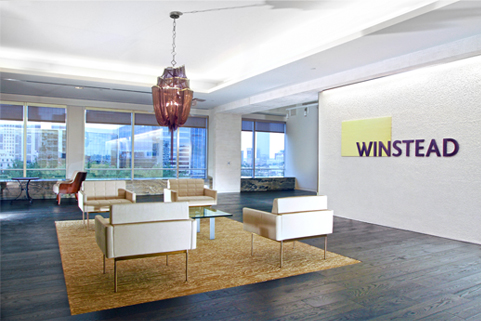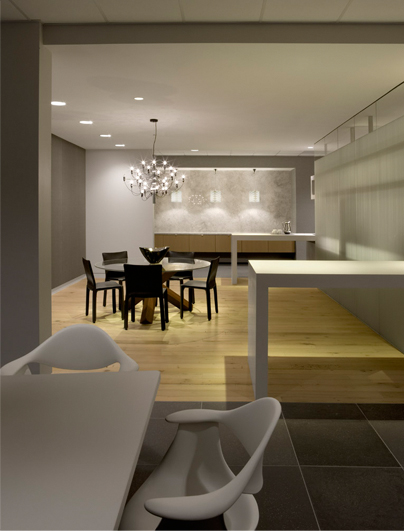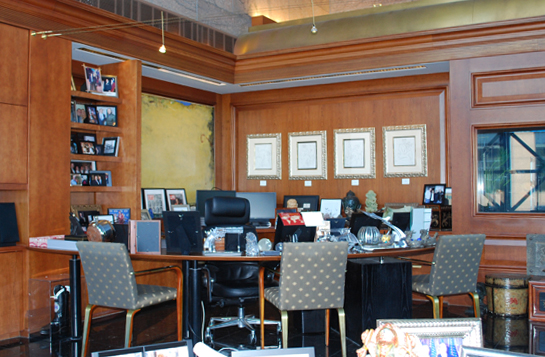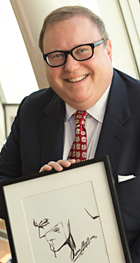© 2013 The Texas Lawbook.
By Patricia Baldwin
Lifestyle Writer for The Texas Lawbook
There was a time, not so long ago, that the title and tenure of an attorney could easily be established by a quick look into his or her office. Size, location, furniture and the number of windows were the “stuff” of office politics – literal “office” politics.
Now, listen to Bob Dylan: The times they are a-changin. Technology, economics and youth are transforming law offices. Of course, there are still some over-the-top offices, but they often are legacies of “go-go” years in the 20th century.
The current hottest trends include: fewer leased square feet per attorney, suburban locations, smaller offices, interior offices, open floor plans, smaller libraries, fewer conference rooms, more multi-purpose spaces, more glass, standardized furniture, consolidated file areas, off-site file storage, clustered spaces for support staff, healthier work environments, sustainability in buildings and build-out, and green spaces.

For example, in October, the Winstead firm moved into its new 134,000-square-foot Dallas headquarters in the Harwood area of Uptown, downsizing from 198,000 square feet in downtown’s Renaissance Tower. Shareholder Nancy Furney acknowledges that some in the firm were “cautious” about the high-rise to mid-rise transition. “For a long time, for a lot of people, being in downtown was ‘status,’” says Furney, chair of the taxation, employee benefits and private business practice group.
After the move? “People are effusive. They love the space.”
Now, with contiguous floors, extensive use of glass, open break areas, outdoor garden seating areas and a 10th floor “community” room and terrace for firm-wide employee use and entertainment, Furney says, “You see people all the time you didn’t see before.”
Furney, who served on the design committee for the relocation, notes, “We included younger people on the committee. This is a place that’s built for the future.”
Winstead’s executive director Howard Mudrick agrees, “One of the things you have to think about, in building out space, is how people are going to be practicing law 10 years from now.” And while he admits the crystal ball is “foggy,” technology clearly shapes the business process and, thus, law office design. “Tools to do your job better continue on the increase.”
Besides the most obvious – the shift of much legal research from the library to the Internet – technology has impacted space planning in other ways. Personal computers and flat screens take less space. Fax machines are gone. Conference rooms feature video conferencing capabilities to support meetings, educational seminars and other gatherings. Skype and GoToMeeting.com often replace the need for travel.
Brian Cassidy, managing partner of the Austin office of Locke Lord, says technology was an important consideration when the firm moved in mid-February five blocks north to 31,000 square feet in One American Center at Sixth Street and Congress Avenue. He says video conferencing makes “cross-selling” seamless for the firm with 13 locations worldwide, allowing lawyers from various offices to work together for the same client. “It’s a better use of people,” he says.
A relocation decision prompts other tough decisions, Cassidy notes. An easy determination for Locke Lord in the state’s capital, however, was to remain downtown close to the Capitol building. The firm also took advantage of the move to shift from a standard-size office for each lawyer to a distinction between partner offices (225-250 square feet) and associate offices (150 square feet).
In Dallas, Winstead also rejected the trending option to make every lawyer’s office the same size. Mudrick explains, “We wanted to promote collaboration.” At Winstead, he says that means more meetings in the larger, partner offices.
Near the Winstead Dallas location, however, two law firms have chosen the one-size-fits-all configuration for attorney offices: SNR Denton on McKinney Avenue in Uptown and Haynes and Boone at One Victory Park.
Mike Moore, managing partner of SNR Denton’s Dallas office, says the “universal office” design allows the flexibility needed to accommodate “attorneys of all levels in the existing office structure.” Since entering Dallas in 2007, the firm has grown to more than 50 lawyers.
“Our forward-thinking approach considered both current and potential future needs of the firm,” Moore adds. “Our approach has been met with broad support and enthusiasm from our attorneys, who recognize the importance of agility and innovation in today’s evolving legal market.” The firm also boasts office space that has received LEED (Leadership in Energy and Environmental Design) certification.

emphasizes smooth lines and light.
Haynes and Boone partner Robert Wilson was managing partner when the firm moved in October 2008. He acknowledges that partners were “skeptical at first” of the new office configuration. “The overwhelming logic of the move to single-size offices carried the day,” he adds. “Now that we have experienced it, we would not consider going back to the multi-size office format.”
Lauckgroup, the design firm for the Winstead space, counts dozens of law firms among its clients. Dallas-based managing principal Anne Kniffen says that the recent economic recession, along with technology, prompted law firms to “radically rethink” the work process. Many firms are changing the one-secretary to one-lawyer ratio to one-secretary to three or four lawyers.
That changing ratio, however, also challenges space requirements.
Dallas-based Kim Hogan, director of interiors for HOK, says, “The biggest question we get from law firms, if they have been in their space eight to 10 years, is about the interior core space they are not using – and the fact they have no [perimeter] space for attorneys.”
Solutions include interior offices for first-year associates and paralegals as well as shared offices, although Hogan says shared offices currently are more prevalent in international practices. The shared office configurations often are set up as mentorships, such as a new associate with a more tenured associate. Movable wall systems also provide an option for maximum flexibility. “De-mountable” partitions, however, are more costly upfront, Hogan says, but “so much easier” than moving walls.
Lauckgroup’s Kniffen suggests the tech-savvy younger generation coming into the legal profession doesn’t care as much about walls as previous generations.
Designers also cite increasing attention to healthier work environments and energy consumption. Topics of conversation include indoor air quality, sustainability, recycling and greening.
Steve Susman, partner at Susman Godfrey, has seen an evolution of offices as the litigation firm expanded from Houston, adding locations in Dallas, Los Angeles, Seattle and New York. Still, Susman has one guiding principle: He forbids lawyers to be involved in the design decisions.
His directions to architects: Offices need to be inexpensive, durable, light, contemporary. And, “glass, glass, glass,” Susman says. Because offices have glass walls, lawyers select furniture from a few choices for consistency.
Latham & Watkins in Houston also opted for consistency by developing a set of furniture for partner offices.
Of course, with constraint often comes creativity. Beyond the new sense and sensibility is an individualization that’s reflected in personal décor and possessions. Offices become the venues for personal taste in artwork and various collections.
At Vinson & Elkins, partners buy their own furniture to reflect an entrepreneurial spirit – and to avoid an institutional look.
Robin Fredrickson, partner at Latham & Watkins, says, “I’m a big fan of stuff,” referring to memorabilia collected over the years and displayed in her office. “My office is very eclectic.” Her prized possessions – dominating the space – are three large “Blue Dog” lithographs by Louisiana artist George Rodrigue.

In fact, the art has inspired something of a common mascot for Fredrickson’s work group. The colleagues have an April commitment to gather at Pinot’s Palette in Houston to paint their own versions of Blue Dog canvases for their conference room.
Artwork from some of the world’s most renowned artists distinguishes the Fish & Richardson offices in Dallas. There are pieces from Pablo Picasso, Salvador Dali, Mimmo Paladino, Roy Lichtenstein, Miani Carnevale and others. Principal Steve Stodghill says, “We would like the office to send the message that we’re on the cutting edge of the practice of law.”

Stodghill’s corner office elicits a kaleidoscope of impressions. It’s ying; it’s yang – and guarded by a life-size replica of Batman. (An adjoining conference room displays one of the country’s largest collections of Batman memorabilia.) A 10-foot by 8-foot painting called “Rite of Spring” dominates a windowed wall. The space also houses a collection of guitars tracing their origins to such musical legends as U2 and the Rolling Stones.
Stodghill’s office walls name-drop for him – with photo after photo of A-list Dallas clients and celebrities, such as Dallas Mavericks owner Mark Cuban, entertainment entrepreneur Todd Wagner, restaurateur Phil Romano, actor George Clooney….

Stodghill’s “irreplaceable” possession is valuable, yet surprisingly understated: a Neal Adams drawing of Batman given to him a decade ago by his wife, Anne. (Adams is known for helping to create the modern imagery of some of DC Comics popular characters.)
As for his expansive – and inherited – office, which features a dramatic glass atrium ceiling, Stodghill notes that, in 2000, the law firm took over the space in Comerica Bank Tower. Originally known as Momentum Place, the building continues to provide a spectacular architectural achievement for the Dallas skyline. Upon its opening in 1987, however, the skyscraper also had the distinction of being the most legally contested building. The Fish & Richardson attorneys are the latest beneficiaries of a previous era’s real estate extravagance.
“This office is somewhat famous in real estate circles,” Stodghill acknowledges. The infamy, however, has nothing to do with law firm “politics.” He notes, with a laugh, “It’s sometimes better to be lucky.”
What’s the most important or most unusual personal possession in your office? Does your firm have an art collection? Please email patricia.baldwin@texaslawbook.net.
© 2013 The Texas Lawbook. Content of The Texas Lawbook is controlled and protected by specific licensing agreements with our subscribers and under federal copyright laws. Any distribution of this content without the consent of The Texas Lawbook is prohibited.
If you see any inaccuracy in any article in The Texas Lawbook, please contact us. Our goal is content that is 100% true and accurate. Thank you.
